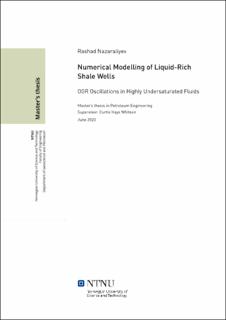| dc.description.abstract | The unconventional petroleum resources have attracted significant attention throughout recent years. These resources are estimated to have reserves greater than those of conventional ones. Increasing energy demands and depletion of conventional petroleum have forced the petroleum industry to thoroughly consider these resources.
The shale reservoirs are a common example of unconventional reservoirs. Due to characteristic low permeability, these reservoirs were challenging for production in the past. Advanced hydraulic fracturing and horizontal drilling technologies and techniques, which allowed to increase the conductivity between rock and wellbore, along with associated reduced costs have made these formations develop economically.
Despite the significant attention and interest on shale reservoirs, they have not been fully studied. This work focuses on the characteristic oil-gas ratio behaviour of liquid-rich shale wells that produce liquid-rich fluids (i.e. condensate gas, wet gas, volatile oil). The idea comes from the study SPE155499. In comparison with the analytical solutions, which show constant OGR behaviour for infinite acting period, numerical studies are associated with OGR oscillations. The study analyses the OGR oscillations in highly undersaturated fluids observed in numerical solutions.
This report is divided into several chapters. Section 1 is a literature review for unconventional petroleum resources and, particularly, liquid-rich shale reservoirs. The section introduces definition and classification for unconventional resources and provides general characteristics for the most common unconventional resources. As the liquid-rich shale reservoirs are the focus area of the study, geology and minerology of shales are described in the chapter, which is followed by the detailed discussion about shale reserves (i.e. shale gas and liquid-rich shale reserves). The description of the fluids in LRS reservoirs are also provided. The production challenges in shale reservoirs are also introduced. Finally, a brief explanation of PVT terminology used in the study is given. Section 2 states the objective of the study. Section 3 describes the software tools used in the project. Section 4 is a chapter for the description of the reservoir model. All the necessary data used to create LRS base case well model is provided in this chapter. The results and discussion for the various case studies are given in Section 5. Each case study and associated definition is described in this section. Finally, all the data necessary to set up the simulation is provided in Appendix. | |
